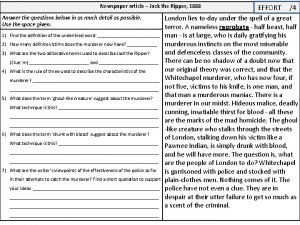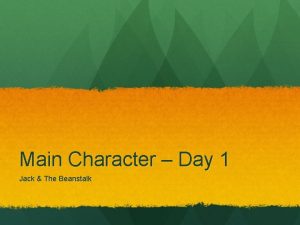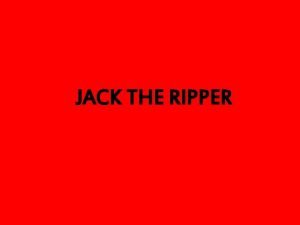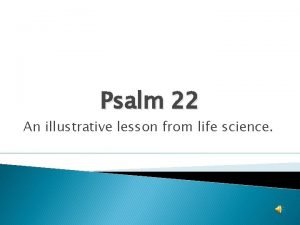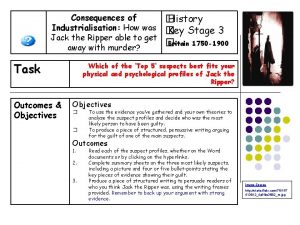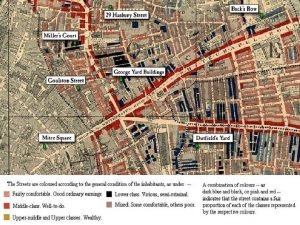Consequences of Industrialisation How was Jack the Ripper












- Slides: 12

Consequences of Industrialisation: How was Jack the Ripper able to get away with murder? � History � Key Stage 3 � Britain 1750 -1900 Task What can the evidence from the other four victims tell us about Jack the Ripper? Outcomes & Objectives � � � To use primary evidence to discover what injuries the Rippers’ other four victims suffered To establish Jack the Rippers’ Modus Operandi To speculate as to the motive and psychological profile of the Ripper Outcomes 1. 2. 3. 4. Read each extract from the Post Mortem examinations and mark onto the diagram the injuries suffered by each victim Mark onto the graph template the level of injury found on each victim Write one paragraph/five bullet-points on what the graph shows you (Is there a pattern to the injuries? ) Use the ‘Detective Notebook’ slide to jot down any important evidence you have found in the injuries or theories you may be forming, particularly regarding motive and personality. Image Source http: //static. flickr. com/75/157 413812_4 a 6 fbc 3582_m. jpg

What can the evidence from the other four victims tell us about Jack the Ripper? What was his M. O. ? l What was his motive? l Are there any other clues? l

Take it Further: http: //www. casebook. org/victims/chapman. html Annie Chapman Report following the post mortem examination: "There was a bruise over the right temple. On the upper eyelid there was a bruise, and there were two distinct bruises, each the size of a man's thumb, on the forepart of the top of the chest. There was a bruise over the middle part of the bone of the right hand. There was an abrasion over the ring finger, with distinct markings of a ring or rings. The throat had been severed as before described. the incisions into the skin indicated that they had been made from the left side of the neck. There were various other mutilations to the body, but he was of the opinion that they occurred subsequent to the death of the woman, and to the large escape of blood from the division of the neck. The abdomen had been entirely laid open: the intestines, severed from their mesenteric attachments, had been lifted out of the body and placed on the shoulder of the corpse; whilst from the pelvis, the uterus and its appendages with the upper portion of the vagina and the posterior two thirds of the bladder, had been entirely removed. No trace of these parts could be found and the incisions were cleanly cut. Obviously the work was that of an expert- of one, at least, who had such knowledge of anatomical or pathological examinations as to be enabled to secure the pelvic organs with one sweep of the knife, which must therefore must have at least 5 or 6 inches in length, probably more. The appearance of the cuts confirmed him in the opinion that the instrument, like the one which divided the neck, had been of a very sharp character. The mode in which the knife had been used seemed to indicate great anatomical knowledge. He thought he himself could not have performed all the injuries he described, even without a struggle, under a quarter of an hour. If he had down it in a deliberate way such as would fall to the duties of a surgeon it probably would have taken him the best part of an hour. " Source: http: //www. casebook. org/victims/chapman. html


Take it Further: http: //www. casebook. org/victims/stride. html Elizabeth Stride “The body was lying on the near side, with the face turned toward the wall, the head up the yard and the feet toward the street. The left arm was extended and there was a packet of cachous in the left hand. The right arm was over the belly, the back of the hand wrist had on it clotted blood. The legs were drawn up with the feet close to the wall. The body and face were warm and the hand cold. The legs were quite warm. Deceased had a silk handkerchief round her neck, and it appeared to be slightly torn. I have since ascertained it was cut. This corresponded with the right angle of the jaw. The throat was deeply gashed and there was an abrasion of the skin about one and a half inches in diameter, apparently stained with blood, under her right arm. There was a clear-cut incision on the neck. It was six inches in length and commenced two and a half inches in a straight line below the angle of the jaw, one half inch in over an undivided muscle, and then becoming deeper, dividing the sheath. The cut was very clean and deviated a little downwards. The arteries and other vessels contained in the sheath were all cut through. The cut through the tissues on the right side was more superficial, and tailed off to about two inches below the right angle of the jaw. The deep vessels on that side were uninjured. From this is was evident that the haemorrhage was caused through the partial severance of the left cartoid artery. ” Source: http: //www. casebook. org/victims/stride. html


Take it Further: http: //www. casebook. org/victims/eddowes. html Catherine Eddowes "The body was on its back, the head turned to left shoulder. The abdomen was exposed. The throat cut across. The intestines were drawn out to a large extent and placed over the right shoulder. A piece of about two feet was quite detached from the body and placed between the body and the left arm, apparently by design. The lobe and auricle of the right ear were cut obliquely through. After washing the left hand carefully, a bruise the size of a sixpence, recent and red, was discovered on the back of the left hand between the thumb and first finger. The face was very much mutilated. There was a cut about a quarter of an inch through the lower left eyelid. The upper eyelid on that side, there was a scratch through the skin on the left upper eyelid, near to the angle of the nose. The right eyelid was cut through to about half an inch. There was a deep cut over the bridge of the nose. This cut went into the bone and divided all the structures of the cheek. We examined the abdomen. The front walls were laid open from the breast bone. The liver was stabbed as if by the point of a sharp instrument. The abdominal walls were divided in the middle line to within a quarter of an inch of the navel. The skin was retracted through the whole of the cut through the abdomen, but the vessels were not clotted. Nor had there been any appreciable bleeding from the vessels. I draw the conclusion that the act was made after death, and there would not have been much blood on the murderer. The cut was made by someone on the right side of the body, kneeling below the middle of the body. Source: http: //www. casebook. org/victims/eddowes. html


Take it Further: http: //www. casebook. org/victims/mary_jane_kelly. html Mary Jane Kelly “The whole of the surface of the abdomen and thighs was removed and the abdominal cavity emptied of its viscera. The breasts were cut off, the arms mutilated by several jagged wounds and the face hacked beyond recognition of the features. The tissues of the neck were severed all round down to the bone. The viscera were found in various parts viz: the uterus and kidneys with one breast under the head, the other breast by the right foot, the liver between the feet, the intestines by the right side and the spleen by the left side of the body. The flaps removed from the abdomen and thighs were on a table. The face was gashed in all directions, the nose, cheeks, eyebrows, and ears being partly removed. The lips were blanched and cut by several incisions running obliquely down to the chin. There were also numerous cuts extending irregularly across all the features. The neck was cut through the skin and other tissues right down to the vertebrae, the fifth and sixth being deeply notched. The air passage was cut at the lower part of the larynx through the cricoid cartilage. The skin and tissues of the abdomen from the costal arch. The right thigh was denuded in front to the bone. The left thigh was stripped of skin fascia, and muscles as far as the knee. The left calf showed a long gash through skin and tissues to the deep muscles and reaching from the knee to five inches above the ankle. Both arms and forearms had extensive jagged wounds. The right thumb showed a small superficial incision about one inch long, with extravasation of blood in the skin, and there were several abrasions on the back of the hand moreover showing the same condition. The lower part of the lung was broken and torn away. The left lung was intact. The pericardium was open below and the heart absent. Source: http: //www. casebook. org/victims/mary_jane_kelly. html


Is there a pattern to the injuries?

Extension Task l Can the students explain the anomaly in the ‘Injuries Graph’? l i. e. that he was disturbed when he’d just murdered Liz Stride. The students should study the Stride evidence and see that her body was warm when discovered by someone coming on a horse-&-cart, so the Ripper would have heard them coming.
 Jack the ripper newspaper article
Jack the ripper newspaper article Describe jack from jack and the beanstalk
Describe jack from jack and the beanstalk The ripper
The ripper Ripper titration
Ripper titration Cloth tape measure target
Cloth tape measure target Coccus ilicis worm
Coccus ilicis worm Actions and their consequences examples
Actions and their consequences examples Act 4 summary romeo and juliet
Act 4 summary romeo and juliet Olavi voittonen
Olavi voittonen Consequences of inflation
Consequences of inflation Positive consequences of assessment on students
Positive consequences of assessment on students Long term anorexia effects
Long term anorexia effects Truancy consequences
Truancy consequences
